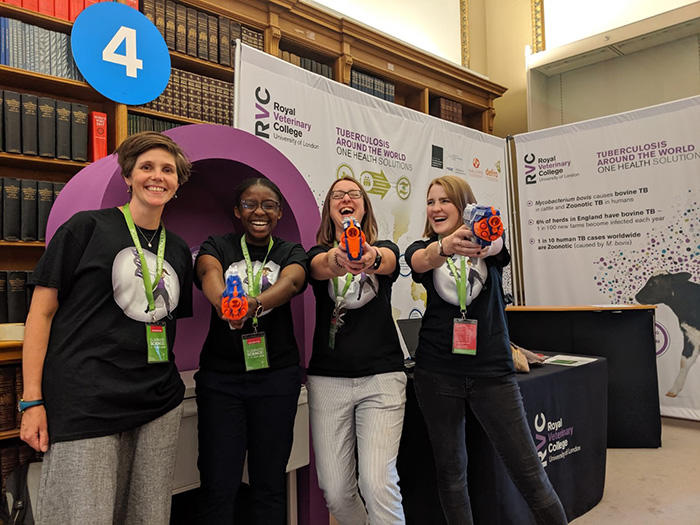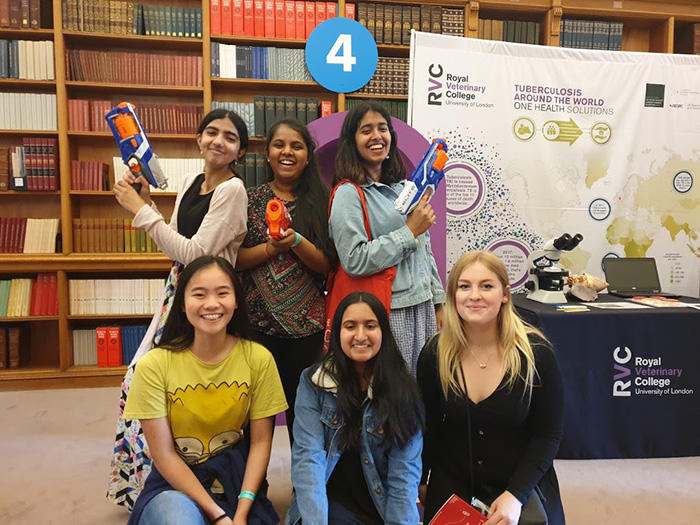The Royal Society Summer Science Exhibition – It’s a Knockout
Posted on September 20, 2019 by Valwynne Faulkner
In July this year, Valwynne Faulkner, PhD student at the Royal Veterinary College (University of London, UK), was part of the Tuberculosis Research Group presenting their work at the Royal Society Summer Science Exhibition. Here, Valwynne describes how the group presented their work in a fun, engaging way and some of the challenges faced during the exhibition.
The Royal Society Summer Science Exhibition, which ran for a week in July, was an awesome display of science at its best and an incredible experience. The Tuberculosis Research Group at the Royal Veterinary College, in which I am currently a PhD student, was thrilled to have the opportunity to share our work at our stand, ‘It’s a Knockout’.
Mycobacterium tuberculosis, which causes human tuberculosis, still holds the title of the world’s leading infectious killer, causing up to 1.7 million deaths in 2017. Mycobacterium bovis also causes disease in people but has a bigger effect in the cattle industry where it has major health and economic impacts. In our lab we use a range of molecular biology tools, including transposon-directed insertion sequencing (TraDIS) and CRISPR interference (CRISPRi), aiming to further understand both of these bacteria and to potentially find novel therapeutics and vaccines. Our stand aimed to highlight the bacteria and to explain how this research is carried out.

My PhD project focuses on using the CRISPRi/dCas9 system to identify essential mycobacterial genes with potential links to antimicrobial resistance, virulence and survival. Despite having previous scientific outreach experience, at the start of the exhibition I found it a bit daunting trying to draw people in and explain the technology in a fun, accessible and engaging way. It helped that the application of CRISPR in healthcare had recently appeared in the media and so people had some idea about the technology. I found it was easier to start conversations with inviting questions, rather than blurting out facts and information. This meant that no two discussions were the same.
Our stand included a foam tunnel shooting range, complete with Nerf guns, foam bullets and genes to ‘Knockout’. This was the highlight of the stand and a great way to engage people across all age groups. Furthermore, it was a great springboard to lead into wider discussions on tuberculosis, gene editing and drug discovery. On display was a plastinated horse’s lung, petri dishes, slides and a microscope. We spoke to people who did not realise that tuberculosis was still an issue, some who knew lots about the disease and its impacts, but also students who find science fascinating and plan to go on to STEM careers. What was amazing about the week was that, through these discussions, I was also able to learn just as much from those visiting the stand as they probably did from me.

What was most challenging, however, was dealing with some members of the public who had preconceptions of what they expect a scientist to look like and who distrusted scientific research. Remaining professional during those uncomfortable moments was quite tough, especially when those views were directed to me personally. For this reason and many others, this experience reaffirmed my belief in the importance of scientific outreach to dispel these myths, engage in conversations with the public to show that the work carried out in labs is ethical and necessary, and to continue to break down the now antiquated scientist stereotype. These experiences nevertheless did not overshadow the phenomenal experiences I had during the week at the Royal Society, explaining what we do and hopefully getting budding scientists more hooked on microbiology. If you ever have the opportunity to take part in the Royal Society Summer Science Exhibition week, don’t miss out on it!

